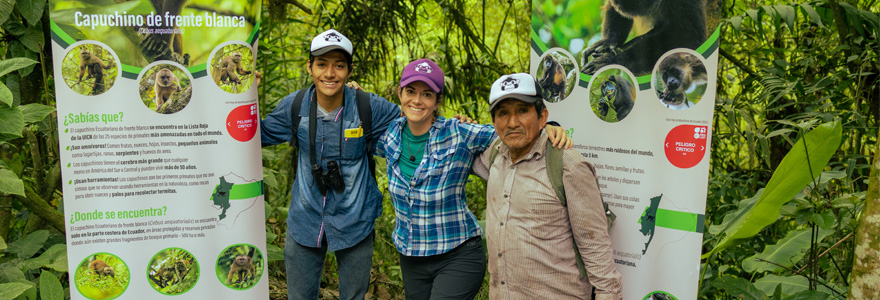
Tamara Britton (centre) with collaborators from local communities at Pacoche Wildlife Refuge in Ecuador. The area is home to the critically endangered Ecuadorian white-fronted capuchin monkey.
Story by Rob Rombouts/ photo provided by Tamara Britton
Tamara Britton, a PhD student in anthropology, believes the key to protecting endangered species and habitats is to recognize the needs of both humans and non-humans. This forms the core of her research and has led to her selection among the finalists of the SSHRC Storytellers Challenge.
The competition asks post-secondary students to explain their SSHRC-funded project in three minutes, or 300 words, or less, focusing on how social sciences and humanities research is affecting our lives, our world and our future for the better. Britton is among twenty-five finalists in the competition.
Through a three-minute video, Britton shared her research on the relationships between people, nonhuman primates and bamboo in the Pacoche Wildlife Refuge in Ecuador. While the wildlife refuge is a protected area, the people living in the area rely on it for subsistence and resources. The bamboo forests in Pacoche are home to a critically endangered primate species – the Ecuadorian white-fronted capuchin (Cebus aequatorialis) – but the local human population also relies on extracting bamboo to make tools and build structures, which puts them in conflict with park regulations.
Yet, Britton said, the local population has an important role to play in maintaining biodiversity. She actively collaborates with people living in the area to make research decisions and plans, and to draw conclusions from the research. Saving endangered species requires wider approaches to conservation than those which place biodiverse areas under the protection of the state or trusts, according to her.
“We need to start listening to local people who are the eyes and ears of the land, and instead of ‘taking their land rights away from them’ and enforcing outsider rules and regulations, we must find ways to combine our perspectives and strengths,” she said.
Ian Colquhoun, a primatologist and one of Britton’s PhD supervisors said major elements of her project are perfect examples of “ethnoprimatology”. This inter-disciplinary research perspective seeks to address 21st century situations where human activities may clash with efforts to conserve natural habitats and the primate species that reside in those habitats.
“The holistic, community-based focus of Tamara’s research highlights the multitude of ways that anthropological research can generate both sociocultural and biological/ecological data that provide crucial understanding of local conditions and situations where important conservation efforts can best be pursued,” said Colquhoun.
“That community involvement at the core of Tamara’s doctoral research is absolutely crucial to ongoing conservation efforts.”
It was important for Britton to tell this story, to change how the relationship between people and nature is viewed.
“I think stories like this one in Pacoche need to be told to break the stereotype that people in parks are a threat to conservation objectives,” she said.
“Protected areas are also social spaces, and this isn’t a threat, it’s a strength. So many conservation stories focus on problems or conflicts, it’s equally as important to focus on potential ‘zones of coexistence’ as well.”
“In a project like Tamara’s, knowledge mobilization is key. That she’s made it so far in the SSHRC Storyteller challenge shows how good she is at communicating the importance of her work to the Canadian public,” said Andrew Walsh, a professor in anthropology and one of Britton’s PhD supervisors.
“Even more impressive is how she has been mobilizing knowledge in Ecuador by using the insights generated by her research to inform ongoing projects with local communities. Tamara has proven herself outstanding at this kind of work.”
Britton has also created the “MonoMico Project” to share the applied conservation work she and her colleagues are doing in the protected area, with people across the province of Manabi in Ecuador. They document their work through photos and videos, and share them through an Instagram account, and private WhatsApp groups.
“The aim is to help inspire local interest and pride in the protection of these endangered species and habitats by documenting our work through photo and video, such as smallholders collecting primate data and giving relatable names to specific groups and individuals,” she said. Through this, she wants to show how scientific knowledge can be combined with local ecological knowledge to help protect coastal primates.
Britton’s contribution to the Storytellers Challenge was an extension of those knowledge mobilization efforts. This year’s Top 25 Storytellers represent postsecondary institutions throughout Canada and were chosen from among nearly 200 applicants.
Each finalist receives $3,000 and a chance at one of the coveted Final Five spots, which come with an additional $1,000. The Final Five winners will be announced at the Congress for the Humanities and Social Sciences on May 29, following a showcase where the finalists will be judged based on their live storytelling skills.

